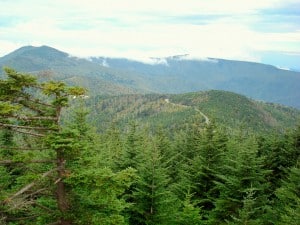Share this article
North Carolina’s sky islands: A step up from the ordinary
Western North Carolina’s remaining red spruce (Picea rubens) and Fraser fir (Abies fraseri) forests compose one of the most imperiled ecosystems in the Southern Appalachians. A Pleistocene relict community, these remnant, isolated, boreal forests dot only the highest elevations across our mountain landscape. Hike in these forests, and not only will you be taking a step back in time, but you’ll have to take a step up (or many!) to get there. On your way, you’ll pass through red oak (Quercus rubra) and Northern hardwoods, red spruce, and eventually reach Fraser fir, typically at 6,000’ or higher. Feel the temperature drop, listen to the stillness around you, and if you enjoy the smell of Christmas trees, breathe deeply!
Many of the remaining spruce-fir forests are now protected in Western North Carolina. However, climate change, encroaching development, disease and exotic pests like the Balsam Wooly Adelgid (Adelges piceae), and intensive forest management practices in the past are all serious threats to this unique habitat type.
As specialized as the spruce-fir forest is, so, too, are the unique plants and animals that live there, many of whom are threatened or endangered themselves. Consider the indomitable Spruce-Fir Moss Spider (Microhexura montivaga), one of the tiniest tarantulas on the planet, with a preference for not-too-moist and not-too-dry moss mats on rock outcrops. Be amazed at the clever aerialist, the Carolina Northern Flying Squirrel (Glaucomys sabrinus coloratus), a small, wide-eyed, nocturnal glider that only dines on the tastiest of underground “truffles,” the fruiting bodies of mychorrizal fungi. Listen for the determined call of the Northern Saw-whet Owl (Aegolius acadicus), a gorgeous, feisty little owl with big-owl attitude. Appreciate the striking, brassy-flecked Weller’s Salamander (Plethodon welleri) named after the teenaged expert herpetologist and naturalist Worth H. Weller who fell to his untimely death in 1931 while exploring the high peaks of North Carolina’s own Grandfather Mountain.
As you make your plans to visit Raleigh for TWS 2016, treat yourself before or after with a trip west to a spruce-fir forest in our mountain region. With hundreds of hiking trails, including parts of the Appalachian Trail and the Mountains-to-Sea Trail, and places to go like the Blue Ridge Parkway, Great Smoky Mountains National Park, Pisgah and Nantahala National Forests, Grandfather Mountain State Park and Mt. Mitchell State Park (the highest peak in the Eastern US at 6,684’), there is no shortage of opportunities to experience these habitats. Bring your binoculars and enjoy the view!
Header Image: A pair of federally endangered Carolina Northern Flying Squirrels (Glaucomys sabrinus coloratus) huddle together after a monitoring survey by North Carolina Wildlife Resources Commission biologists. ©Jonathan Mays









